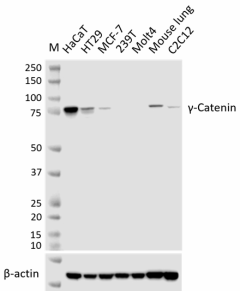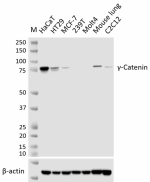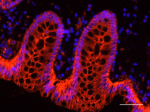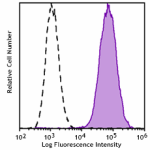- Clone
- W22004E (See other available formats)
- Regulatory Status
- RUO
- Other Names
- Catenin gamma, Desmoplakin III, desmoplakin-3, DP3CTNNG, DPIII, gamma-catenin, junction plakoglobin, PDGBARVD12, PKGB, JUP, dp3, Catenin (Cadherin-associated Protein), Gamma 80kDa, CTNNG, PDGB, Desmoplakin 3
- Isotype
- Rat IgG2b, κ

-

Whole cell extracts (15 µg total protein per lane) from the indicated cell lines were resolved on a 4-12% Bis-Tris gel, transferred to a PVDF membrane, and probed with 1 µg/mL of purified anti-γ-Catenin (clone W22004E) overnight at 4°C. Proteins were visualized by chemiluminescence detection using HRP Goat anti-rat IgG (Cat. No. 405405) at a 1:5000 dilution. Direct-Blot™ HRP anti-β-actin (Cat. No. 664804) was used as a loading control at a 1:25000 dilution. Western-Ready™ ECL Substrate Premium Kit (Cat. No. 426319) was used as a detection reagent. Lane M: Molecular weight marker -

IHC staining using purified anti-γ-Catenin (clone W22004E) on formalin-fixed paraffin-embedded human colon tissue. Following antigen retrieval using 1X Citrate buffer (Cat. No. 420901), the tissue was incubated with 5 µg/mL of purified anti-γ-Catenin (clone W22004E) overnight at 4°C, followed by incubation with 2.5 µg/mL of Alexa Fluor® 647 Goat anti-rat IgG (red) (Cat. No. 405416) for one hour at room temperature. Nuclei were counterstained with DAPI (blue) (Cat. No. 422801). The image was captured with a 40X objective. Scale bar: 50 µM -

IHC staining using purified anti-γ-Catenin (clone W22004E) on formalin-fixed paraffin-embedded human skin tissue. Following antigen retrieval using 1X Citrate buffer (Cat. No. 420901), the tissue was incubated with 1 µg/mL of purified anti-γ-Catenin (clone W22004E) overnight at 4°C, followed by incubation with 2.5 µg/mL of Alexa Fluor® 647 goat anti-rat IgG (red) (Cat. No. 405416) for one hour at room temperature. Nuclei were counterstained with DAPI (blue) (Cat. No. 422801). The image was captured with a 40X objective. Scale bar: 50 µM -

HaCat cells were fixed with 4% paraformaldehyde for 10 minutes, permeabilized with 0.5% Triton X-100, and blocked with 5% FBS for 1 hour at room temperature. Cells were then intracellularly stained with 5.0 µg/mL of purified anti-γ-Catenin (clone W22004E), followed by incubation with 2.5 µg/mL of Alexa Fluor® 488 Goat anti-rat IgG (Cat. No. 405418) for 1 hour at room temperature (panel A). Nuclei were counterstained with DAPI (Cat. No. 422801) and F-actin was counterstain with Flash Phalloidin™ Red 594 (Cat. No. 424203) (panel B). The image was captured with a 40X objective. Scale bar: 25 µm -

HaCaT cells were fixed and permeabilized with Cyto-Fast™ Fix/Perm Buffer set (Cat. No. 426803). Then cells were intracellularly stained with purified anti-γ-Catenin (clone W22004E) (filled histogram) or purified rat IgG2b, κ isotype control (open histogram, dashed line) (Cat. No. 400602), followed by APC Goat anti-rat IgG (Cat. No. 405407).
| Cat # | Size | Price | Quantity Check Availability | ||
|---|---|---|---|---|---|
| 624051 | 25 µg | $190.00 | |||
| 624052 | 100 µg | $470.00 | |||
γ-Catenin, also called plakoglobin or JUP, is a member of the armadillo family of signaling molecules. γ-Catenin plays an important role in cell adhesion with α-catenin and β-catenin, participates in Wnt signaling, embryonic development and tumorigenesis. Though β-catenin and γ-Catenin share sequence homology, γ-catenin has distinct N- and C-terminal regions which imparts distinct functions through interaction with various protein partners. Recent evidence indicates that γ-Catenin modulates desmosomal adhesion in response to growth factor stimulation. Transgenic mice homozygous with a null mutation of the γ-Catenin gene die during the embryonic stage, approximately on the 12th day of development, due to significant abnormalities in the adherens junctions and the absence of properly functioning desmosomes in the heart. The alteration of the γ-Catenin gene has been suggested as a contributing factor in the development of the heart disease called arrhythmogenic right ventricular dysplasia (ARVD) or arrhythmogenic right ventricular cardiomyopathy. Specifically, the mutations in γ-Catenin result in an autosomal recessive type of the disease known as Naxos disease.
Product Details
- Verified Reactivity
- Human, Mouse
- Antibody Type
- Monoclonal
- Host Species
- Rat
- Immunogen
- Partial Recombinant human γ-Catenin protein
- Formulation
- Phosphate-buffered solution, pH 7.2, containing 0.09% sodium azide
- Preparation
- The antibody was purified by affinity chromatography.
- Concentration
- 0.5 mg/mL
- Storage & Handling
- The antibody solution should be stored undiluted between 2°C and 8°C.
- Application
-
WB - Quality tested
IHC-P, ICC, ICFC - Verified - Recommended Usage
-
Each lot of this antibody is quality control tested by western blotting. For western blotting, the suggested use of this reagent is 0.125 - 1.0 µg/mL. For immunohistochemistry on formalin-fixed paraffin-embedded tissue sections, a concentration range of 1.0 - 10.0 µg/mL is suggested. For immunocytochemistry, a concentration range of 1.0 - 5.0 μg/mL is recommended. For flow cytometric staining, the suggested use of this reagent is ≤ 0.06 µg per million cells in 100 µL volume. It is recommended that the reagent be titrated for optimal performance for each application.
- Application Notes
-
This clone cross-reacts with mouse γ-Catenin.
For immunocytochemistry (ICC), the suggested fixation/permeabilization method is either 4% paraformaldehyde/0.5% Triton X-100 or paraformaldehyde followed by ice-cold methanol or fixed with ice-cold methanol only.
For immunohistochemistry (IHC-P), the suggested antigen retrieval buffer is Citrate Buffer (Cat. No. 420901) or Tris-EDTA pH 9.0.
For ICFC (intracellular flow cytometry) staining with this clone, we recommended using Cyto-Fast™ Fix/Perm Buffer Set (Cat. No. 426803) or True-Nuclear™ Transcription Factor Buffer Set (Cat. No. 424401). True-Phos™ Perm Buffer (Cat. No. 425401) and Intracellular Staining Permeabilization Wash Buffer (Cat. No. 421002) are not applicable. - RRID
-
AB_3097234 (BioLegend Cat. No. 624051)
AB_3097234 (BioLegend Cat. No. 624052)
Antigen Details
- Structure
- γ-Catenin is a 745 amino acid protein with a predicted molecular weight of 82 kD
- Distribution
-
Cardiac cells
- Function
- Regulation of cell-cell adhesion
- Interaction
- MUC1, CAV1, PTPRJ, DSG1, DSC1, DSC2, PKP2
- Biology Area
- Cell Adhesion, Cell Biology, Cell Motility/Cytoskeleton/Structure, Signal Transduction
- Antigen References
-
- Zhurinsky J, et al. 2000. J Cell Sci. 113:3127-39.
- Zhurinsky J, et al. 2000. Mol Cell Biol. 20:4238-53.
- Charpentier E, et al. 2000. J Cell Biol. 149:503-20.
- Kolligs FT, et al. 2000. Genes Dev. 14:1319-31.
- Yin T, et al. 2005. J Biol Chem. 280:40355-63.
- Ruiz P, et al. 1996. J Cell Biol. 135:215-25.
- Bierkamp C, et al. 1996. Dev Biol. 180:780-85.
- Zhang Z. et al. 2015. J Clin Invest. 125:1708-12.
- Li D. et al. 2015. J Biol Chem. 287:10435-43.
- Rampazzo A. 2006. Heart Int. 2:17.
- Gene ID
- 3728 View all products for this Gene ID
- UniProt
- View information about γ-Catenin on UniProt.org
Other Formats
View All gamma-Catenin Reagents Request Custom Conjugation| Description | Clone | Applications |
|---|---|---|
| Purified anti-γ-Catenin | W22004E | WB,ICC,IHC-P,ICFC |
Compare Data Across All Formats
This data display is provided for general comparisons between formats.
Your actual data may vary due to variations in samples, target cells, instruments and their settings, staining conditions, and other factors.
If you need assistance with selecting the best format contact our expert technical support team.
-
Purified anti-γ-Catenin

Whole cell extracts (15 µg total protein per lane) from the ... 
IHC staining using purified anti-γ-Catenin (clone W22004E) o... 
IHC staining using purified anti-γ-Catenin (clone W22004E) o... 
HaCat cells were fixed with 4% paraformaldehyde for 10 minut... 
HaCaT cells were fixed and permeabilized with Cyto-Fast™ Fix...
